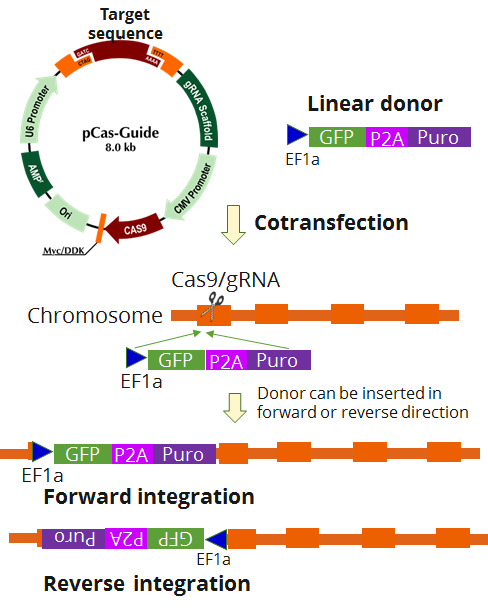Fxyd2 Mouse Gene Knockout Kit (CRISPR)
CAT#: KN506192
Fxyd2 - KN2.0, Mouse gene knockout kit via CRISPR, non-homology mediated.
KN2.0 knockout kit validation
KN506192 is the updated version of KN306192.
USD 1,290.00
2 Weeks*
Size
Other products for "Fxyd2"
Specifications
| Product Data | |
| Format | 2 gRNA vectors, 1 linear donor |
| Donor DNA | EF1a-GFP-P2A-Puro |
| Symbol | Fxyd2 |
| Locus ID | 11936 |
| Disclaimer | The kit is designed based on the best knowledge of CRISPR technology. The system has been functionally validated for knocking-in the cassette downstream the native promoter. The efficiency of the knock-out varies due to the nature of the biology and the complexity of the experimental process. |
| Reference Data | |
| RefSeq | NM_007503, NM_052823, NM_052824, NR_028499 |
| Synonyms | Atp1g1 |
| Summary | This gene encodes a member of a family of small membrane proteins that share a 35-amino acid signature sequence domain, beginning with the sequence PFXYD and containing 7 invariant and 6 highly conserved amino acids. The approved human gene nomenclature for the family is FXYD-domain containing ion transport regulator. Mouse FXYD5 has been termed RIC (Related to Ion Channel). FXYD2, also known as the gamma subunit of the Na,K-ATPase, regulates the properties of that enzyme. FXYD1 (phospholemman), FXYD2 (gamma), FXYD3 (MAT-8), FXYD4 (CHIF), and FXYD5 (RIC) have been shown to induce channel activity in experimental expression systems. Transmembrane topology has been established for two family members (FXYD1 and FXYD2), with the N-terminus extracellular and the C-terminus on the cytoplasmic side of the membrane. The Type III integral membrane protein encoded by this gene is the gamma subunit of the Na,K-ATPase present on the plasma membrane. Although the Na,K-ATPase does not depend on the gamma subunit to be functional, it is thought that the gamma subunit modulates the enzyme's activity by inducing ion channel activity. Multiple transcript variants have been described for this gene that are expressed in tissue-specific and developmental stage-specific patterns and encode proteins that differ at the N-terminus. [provided by RefSeq, Sep 2009] |
Documents
| Product Manuals |
| FAQs |
| SDS |
Resources
Other Versions
| SKU | Description | Size | Price |
|---|---|---|---|
| GA200319 | Fxyd2 CRISPRa kit - CRISPR gene activation of mouse FXYD domain-containing ion transport regulator 2 |
USD 1,290.00 |
{0} Product Review(s)
0 Product Review(s)
Submit review
Be the first one to submit a review
Product Citations
*Delivery time may vary from web posted schedule. Occasional delays may occur due to unforeseen
complexities in the preparation of your product. International customers may expect an additional 1-2 weeks
in shipping.






























































































































































































































































 Germany
Germany
 Japan
Japan
 United Kingdom
United Kingdom
 China
China
